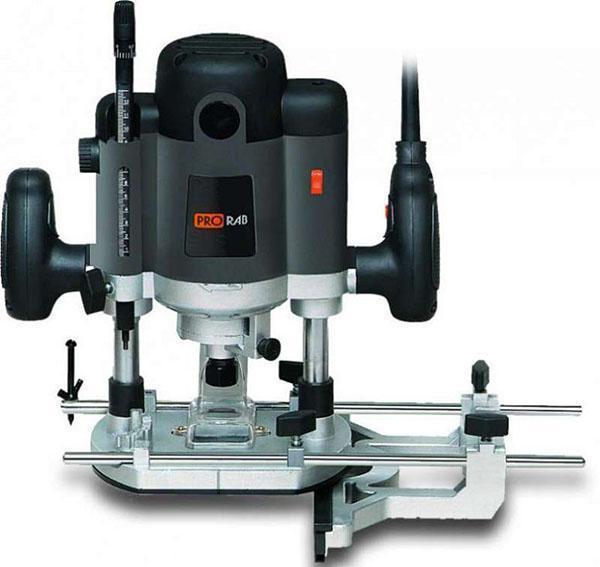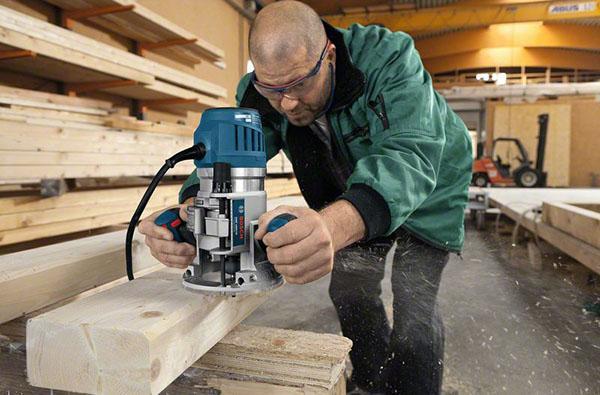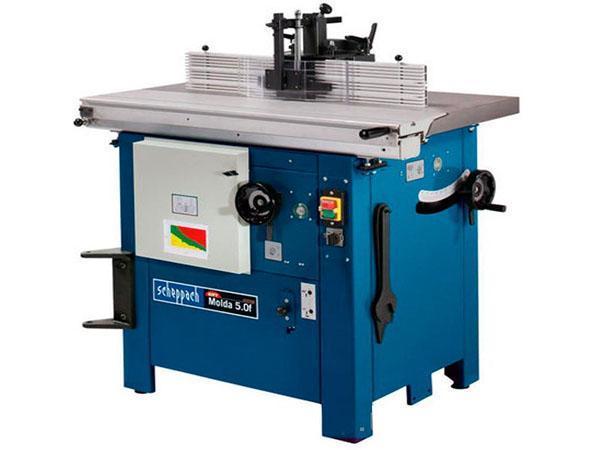How to choose a wood milling machine
 The hand tools used for processing wood and wood products at home include a wood milling machine. This tool has an extremely wide range of applications, and is used for various manipulations carried out with wood products or parts.
The hand tools used for processing wood and wood products at home include a wood milling machine. This tool has an extremely wide range of applications, and is used for various manipulations carried out with wood products or parts.
However, for successful work with such a tool, you need to choose the right model for a certain type of work and choose the right nozzle. The types of machines for processing wood, as well as all kinds of attachments for performing work will be discussed in this article.
Read the article: wood carving lessons!
Purpose and scope of hand routers

- trimming or grinding off excess layers of wood;
- creating holes in wooden parts (including holes for door locks and handles);
- turning of wooden parts, including various planks, bars, boards;
- installation of wooden windows;
- installation of doors;
- processing of wooden skirting boards and so on.
The manual wood router is only intended for processing small parts, it cannot be used for processing large timber or large installations.
Types of milling machines and their brief description
 All machines are divided into several groups:
All machines are divided into several groups:
- depending on engine power;
- by the type of impact on the material.
 These characteristics affect the scope of the device. Depending on the engine power, all wood milling machines are divided into:
These characteristics affect the scope of the device. Depending on the engine power, all wood milling machines are divided into:
- heavy;
- moderate;
- lungs.
If we talk about specific numbers, then in heavy machines the engine power reaches 1200 watts. However, such devices are most often used for professional work, and not for home manual work. Much depends on the desired scope of application of the device, the frequency of its use and the specific type of work performed.
Medium-heavy machines have motor power from 750 W to 900 W. Such devices are most often used for home wood processing. They are quite functional, this power is enough to carry out almost any homework in which it is necessary to use a wood router. With a machine with an engine of this power, you can do decorative woodworking and furniture assembly.
Lightweight machines have engine power up to 750 W. Such a machine is also suitable for performing minor work, but if the machine is used often enough, then it is better to give preference to a more expensive, but also more functional device with a higher engine power.
 Wood milling machines used in home workshops are also divided according to the type of effect on the material. They are:
Wood milling machines used in home workshops are also divided according to the type of effect on the material. They are:
- motionless;
- submersible.
The main difference between fixed routers is that the metal bar in them is not adjustable in height. Thus, the functionality of such a device is minimal.
As for submersible machines, their design allows you to adjust the depth of immersion of the router into the material, the accuracy of milling and other parameters of material processing. With the help of such devices, you can create a variety of parts, and process almost any piece of wood. Of course, such cars are much more expensive, but their price is fully justified by the functionality.
Choosing a milling cutter
 The processing of a wooden part is done directly with a milling knife. Different knives are used for different types of treatments.
The processing of a wooden part is done directly with a milling knife. Different knives are used for different types of treatments.
Choosing the right router bit for a handheld wood router is the key to successful woodworking.
In general, all cutters can be divided into several categories:
- end type;
- groove;
- edging.
End mills are some of the simplest in design. Outwardly, they resemble conventional drills, but at the end of the working length they do not have a tapered part. One of the main features of such cutters is that there are also cutting teeth on their end part. This means end mills can be used for:
- cutting wood blanks;
- sampling a quarter;
- edge processing;
- creating a through-type groove;
- drilling.
With the help of such knives, the contours of wooden parts and stepped surfaces are also processed.
The purpose of groove cutters is quite consistent with their name - they are used to create grooves of various shapes and sizes on a piece of wood being processed. Nevertheless, groove cutters for a wood router can be roughly divided into several categories:
- Direct. Used to sample grooves of a rectangular profile.
- Shaped. With the help of them, it is possible to create a groove of a certain curly configuration, depending on the cutter.
- Dovetail configuration.
- Cutters for creating T-shaped grooves.
- Tapered cutters (used to create V-grooves and for engraving).
- Fillet (for decorative processing of wood products).
Cutters, called edge cutters, have the largest number of subspecies and subdivisions. They are most often used when working with a wood milling machine. They can be:
- straight;
- curly (or profile);
- figrean;
- cone type;
- molding;
- fillet;
- microthorn.
Straight cutters are also called copy cutters. Most often they are equipped with special bearings that guide the action of the knife. Thanks to this, it is possible to create perfectly smooth edges on the surface of a wooden product.
The profile, or figured cut, is designed to give the edge of a wooden product a certain figured structure.
Cutters called figurines are used mainly for the manufacture of baseboards.
Tapered cutters are used to cut a product at a specific angle. It is possible to achieve such a processing format due to the fact that such a cutter knife is equipped with a guide bearing.
Molding cutters are used to round off the cuts of a wooden beam. Most often they also have a pilot bearing.
Fillet, as well as molding, designed for processing a cut in the form of an arc. However, their main feature is that they can give the product not only a convex, but also a concave shape. If you compare the molding and fillet milling cutters, you will notice that they are mirror images of each other.
A micro-tenon cutter is used to create tenons. The thin triangular tenons that are created with this tool are used to connect two wooden pieces. With the help of these spikes, the joints are strengthened.
Precautions and safety measures when working with hand-held milling machines
 The basic safety rules when processing wood products with your own hands using a wood milling machine are described in the operating instructions attached to this device.
The basic safety rules when processing wood products with your own hands using a wood milling machine are described in the operating instructions attached to this device.
Before starting to work with a new tool, you must read its operating instructions. This will protect the machine operator from injury, and the machine itself from damage and early depreciation.
Moreover, when working with such a tool, it is recommended to wear protective goggles and a respirator, due to the formation of a large amount of dust. These precautions should not be neglected. Moreover, it is necessary to wear headphones or earplugs on the ears, which will protect the hearing from the negative effects of this level of noise.
In the absence of special protective equipment, you can do with ordinary cotton wool, which is plugged into the auricles.
As you can see from the material described in this article, when choosing a machine for manual woodworking, you should pay special attention to the functionality of the machine and its intended purpose, as well as the scope. For processing wood products at home, manual wood milling machines are quite suitable, but the modern market also offers many models of CNC machines (with numerical control). Is such a machine functional? Yes. However, it is not suitable for small work at home, as it requires great work skills and knowledge of numerical programming to operate this machine.